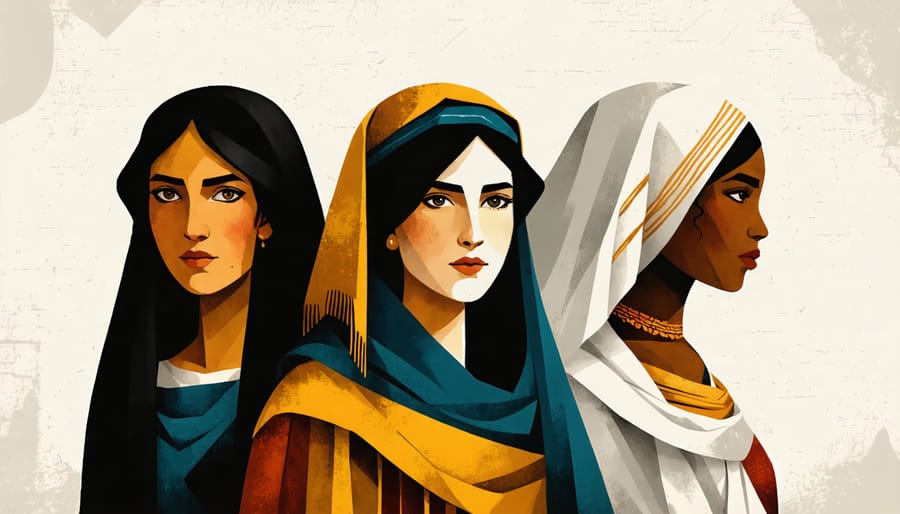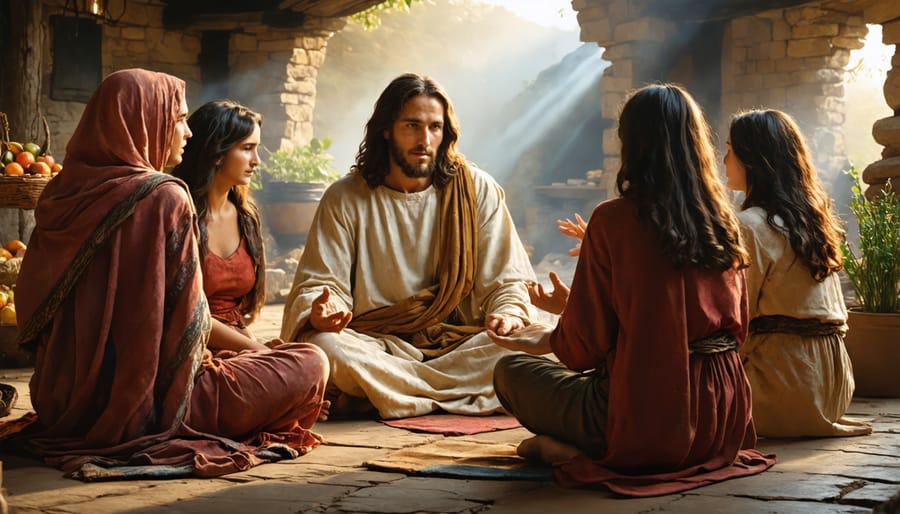Few topics in modern Christianity spark more passionate discussion than gender roles in the Bible. From the creation narrative in Genesis to Paul’s letters to early churches, Scripture presents a rich tapestry of teachings about men and women that continues to shape faith communities today. Yet beneath the surface of familiar verses lies a deeper story of God’s divine design for human relationships and His heart for both men and women made in His image.
Understanding Biblical gender roles requires careful examination of both historical context and eternal truths. While some passages seem straightforward, others challenge our modern sensibilities and demand thoughtful interpretation. The Bible’s teaching on gender encompasses not just rules and roles, but reveals God’s perfect plan for human flourishing through complementary relationships that reflect His character.
As we explore this vital topic, we’ll examine key Scripture passages with fresh eyes, seeking to understand God’s original intent while applying His timeless wisdom to contemporary questions. Whether you’re wrestling with traditional interpretations or seeking Biblical foundations for gender discussions in today’s world, this journey through Scripture offers transformative insights for both personal growth and kingdom impact.
Gender Roles in Creation and Early Biblical History
The Creation Account
The Biblical creation account provides foundational insights into God’s design for gender roles and relationships. In Genesis 1:27, we read that “God created mankind in his own image, in the image of God he created them; male and female he created them.” This verse establishes the equal dignity and worth of both men and women as image-bearers of God.
Genesis 2 offers additional details about the creation of man and woman. God first created Adam and gave him the responsibility to tend the garden. Recognizing that it was not good for man to be alone, God created Eve as a “suitable helper” or “ezer kenegdo” in Hebrew. This term, far from implying subordination, is used elsewhere in Scripture to describe God Himself as Israel’s helper, suggesting strength and essential partnership.
The creation of Eve from Adam’s rib symbolizes the intimate connection and interdependence between men and women. When Adam sees Eve, he exclaims, “This is now bone of my bones and flesh of my flesh” (Genesis 2:23), expressing joy in finding a companion who perfectly complements him. Together, they were given the mandate to be fruitful, multiply, and exercise stewardship over creation.
This account establishes that men and women, while distinct, were created to work together in partnership, each bringing unique and valuable contributions to their shared calling. Their relationship before the Fall demonstrates God’s original intent for harmony and mutual support between the sexes.

Effects of the Fall
The entrance of sin into the world through the Fall profoundly impacted the relationship between men and women, introducing discord into what God had designed to be a harmonious partnership. In Genesis 3:16-19, we see the immediate consequences of sin affecting both genders differently, yet equally significantly. The perfect unity and mutual support that characterized Adam and Eve’s relationship in Eden became strained by blame, shame, and power struggles.
Where there was once perfect cooperation, sin introduced competition. The original design of complementary roles became distorted by dominance and submission patterns that God never intended. This distortion has manifested throughout history in various forms of gender-based inequality and abuse, far from God’s redemptive plan for humanity.
The Fall’s effects extended beyond individual relationships to impact family dynamics as a whole. Work, which was originally meant to be fulfilling, became toilsome. Child-bearing, while remaining a blessing, became associated with pain. These consequences continue to influence gender relationships today, often creating tension between biblical teachings and cultural expectations.
However, understanding these effects helps us recognize our need for restoration and healing through Christ. While we live with the reality of the Fall, we can work toward redemption by pursuing relationships that reflect God’s original design of mutual respect, love, and support between men and women.
Family Structures in Old Testament Times
Patriarchal Society
To understand biblical gender roles, we must first consider the ancient cultural context in which Scripture was written. In biblical times, societies were predominantly organized around patriarchal family structures, where fathers and husbands held primary leadership responsibilities for their households.
This family structure reflected the social and economic realities of ancient Near Eastern cultures, where extended families lived together and worked collaboratively for survival. The patriarch was responsible for protecting, providing for, and spiritually guiding his family members. This responsibility came with both privileges and serious obligations before God and the community.
However, it’s important to note that biblical patriarchy differed from other ancient cultures in significant ways. While surrounding societies often treated women as property, the Bible consistently affirmed women’s dignity as image-bearers of God. Examples like Deborah, Ruth, and Proverbs 31 demonstrate that women held respected roles and exercised significant influence in biblical times.
Understanding this historical context helps us appreciate how revolutionary Jesus’s treatment of women was for His time. He consistently showed respect to women, taught them alongside men, and appeared first to women after His resurrection. The Apostle Paul’s teachings about marriage, while working within existing social structures, emphasized mutual submission and sacrificial love rather than domination.
This historical perspective helps us better understand biblical passages about gender roles while recognizing God’s consistent affirmation of human dignity and worth regardless of gender.
Women of Valor
The Bible is rich with examples of women who demonstrated extraordinary faith, leadership, and influence in God’s redemptive plan. Deborah served as both a prophet and judge, leading Israel with wisdom and courage. Her leadership inspired military commander Barak and brought victory to God’s people. Ruth’s unwavering loyalty and faith not only secured her place in Jesus’s genealogy but also exemplified sacrificial love and devotion.
Esther’s courage in approaching the king to save her people shows how God uses women in positions of influence to accomplish His purposes. The Proverbs 31 woman, often cited as a model of biblical womanhood, demonstrates strength, wisdom, and entrepreneurial spirit while caring for her household and community.
In the New Testament, Mary’s humble submission to God’s plan made her the mother of Jesus, while her relative Elizabeth’s faith was rewarded in her later years. Mary Magdalene’s devotion to Jesus earned her the privilege of being the first witness to His resurrection. Priscilla, alongside her husband Aquila, taught theology and helped establish early churches, demonstrating that women played vital roles in ministry and teaching.
These women of valor challenge simplistic stereotypes about biblical gender roles. They show that godly women can be leaders, entrepreneurs, teachers, and warriors while remaining faithful to God’s calling. Their stories remind us that God gifts and calls women to various roles and ministries, using their unique strengths to advance His kingdom.

New Testament Teachings on Gender Roles
Jesus’s Revolutionary Approach
Jesus’s ministry marked a dramatic shift in how women were viewed and treated in religious contexts. During a time when women were often marginalized, Jesus consistently demonstrated respect, dignity, and equality in His interactions with both men and women. He taught women directly, which was unusual for rabbis of His time, as seen in His interaction with Mary who sat at His feet to learn – a position traditionally reserved for male disciples.
Consider how Jesus first revealed His messiahship to the Samaritan woman at the well, engaging her in profound theological discussion. He defended women’s honor, as when He protected the woman caught in adultery from those who would stone her. After His resurrection, Jesus chose to appear first to women, making them the initial witnesses of this pivotal event – a remarkable choice in a culture where women’s testimony was not valued in legal proceedings.
Throughout His ministry, Jesus elevated the status of both genders by emphasizing their equal worth before God. He healed women and men alike, taught them with equal authority, and included them in His broader mission. His approach wasn’t about diminishing either gender but rather about restoring the dignity of all people as image-bearers of God.
Jesus modeled servant leadership for men while affirming women’s full personhood and spiritual capacity. His revolutionary approach challenges us today to move beyond cultural limitations and see each person’s inherent value in God’s kingdom.

Paul’s Instructions to Families
Paul’s letters to early Christian communities contain important guidance about family relationships, which require careful Biblical interpretation to understand their historical context. In Ephesians 5:21-6:4 and Colossians 3:18-21, Paul addresses households within the cultural framework of first-century Roman society while introducing revolutionary Christian principles of mutual respect and sacrificial love.
When Paul instructs wives to submit to their husbands, he immediately balances this with the command for husbands to love their wives sacrificially, just as Christ loved the church. This was a radical departure from the patriarchal norms of the time, establishing a foundation of mutual care and respect within Christian marriages.
Similarly, Paul’s instructions about children honoring their parents and fathers not provoking their children to anger reflect God’s heart for healthy family relationships. These teachings emphasized the importance of nurturing and respectful parenting, rather than the harsh authority common in Roman households.
Understanding these passages requires considering both their historical setting and their enduring spiritual principles. Paul’s guidance consistently points to Christ-like love, mutual submission, and respect as the cornerstones of Christian family life, principles that remain relevant for modern families seeking to honor God in their relationships.
Mutual Submission and Love
At the heart of biblical teaching on gender roles lies the principle of mutual submission and sacrificial love, as exemplified in Ephesians 5:21: “Submit to one another out of reverence for Christ.” This foundational concept transforms our understanding of relationship dynamics within marriage and the broader Christian community.
Christ’s example of servant leadership sets the standard for how we should relate to one another. Just as He washed His disciples’ feet and gave His life for the church, husbands are called to love their wives sacrificially. Similarly, the mutual respect and honor described in Scripture creates an atmosphere of Biblical balance where both partners flourish.
This model of reciprocal love and submission stands in stark contrast to worldly power dynamics. Rather than focusing on authority and control, Scripture emphasizes the importance of putting others’ needs before our own. Philippians 2:3-4 instructs us to “do nothing out of selfish ambition or vain conceit. Rather, in humility value others above yourselves, not looking to your own interests but each to the interests of the others.”
When both spouses embrace this Christ-centered approach, their relationship reflects God’s design for marriage. It creates a safe environment where both partners can grow spiritually, use their gifts freely, and honor God through their unique roles while supporting one another in love.
As we reflect on the Biblical teachings about gender roles, we find a beautiful tapestry of divine wisdom that continues to offer guidance for our modern lives. Throughout Scripture, we see God’s perfect design in creating both men and women in His image, each with unique qualities and contributions to make in building His kingdom. While cultural contexts have changed dramatically since Biblical times, the core principles of mutual respect, sacrificial love, and spiritual equality remain timeless and relevant.
It’s essential to remember that Jesus himself demonstrated a revolutionary approach to gender relationships in His time, treating women with dignity and respect when society often marginalized them. This example calls us to examine how we can honor both Biblical truth and the inherent worth of all people in our contemporary settings.
As we seek to apply Biblical wisdom to modern gender roles, let’s focus on three key principles: First, embracing our God-given identity while recognizing the equal value of all people before Christ. Second, understanding that different roles can coexist with equal worth and dignity. Third, approaching these matters with humility, grace, and love, knowing that our ultimate goal is to glorify God and build up His church.
We must remember that discussions about gender roles should never become barriers to sharing Christ’s love or building authentic Christian community. Instead, let these conversations be opportunities to demonstrate Christ-like love, understanding, and respect for one another. Whether in our families, churches, or broader communities, we can honor Biblical principles while showing grace to those who may see things differently.
Let us move forward with wisdom and compassion, seeking God’s guidance through prayer and Scripture as we navigate these important matters. May our approach to gender roles reflect the heart of Jesus, bringing unity rather than division, and pointing others to the transformative power of God’s love in our lives.
